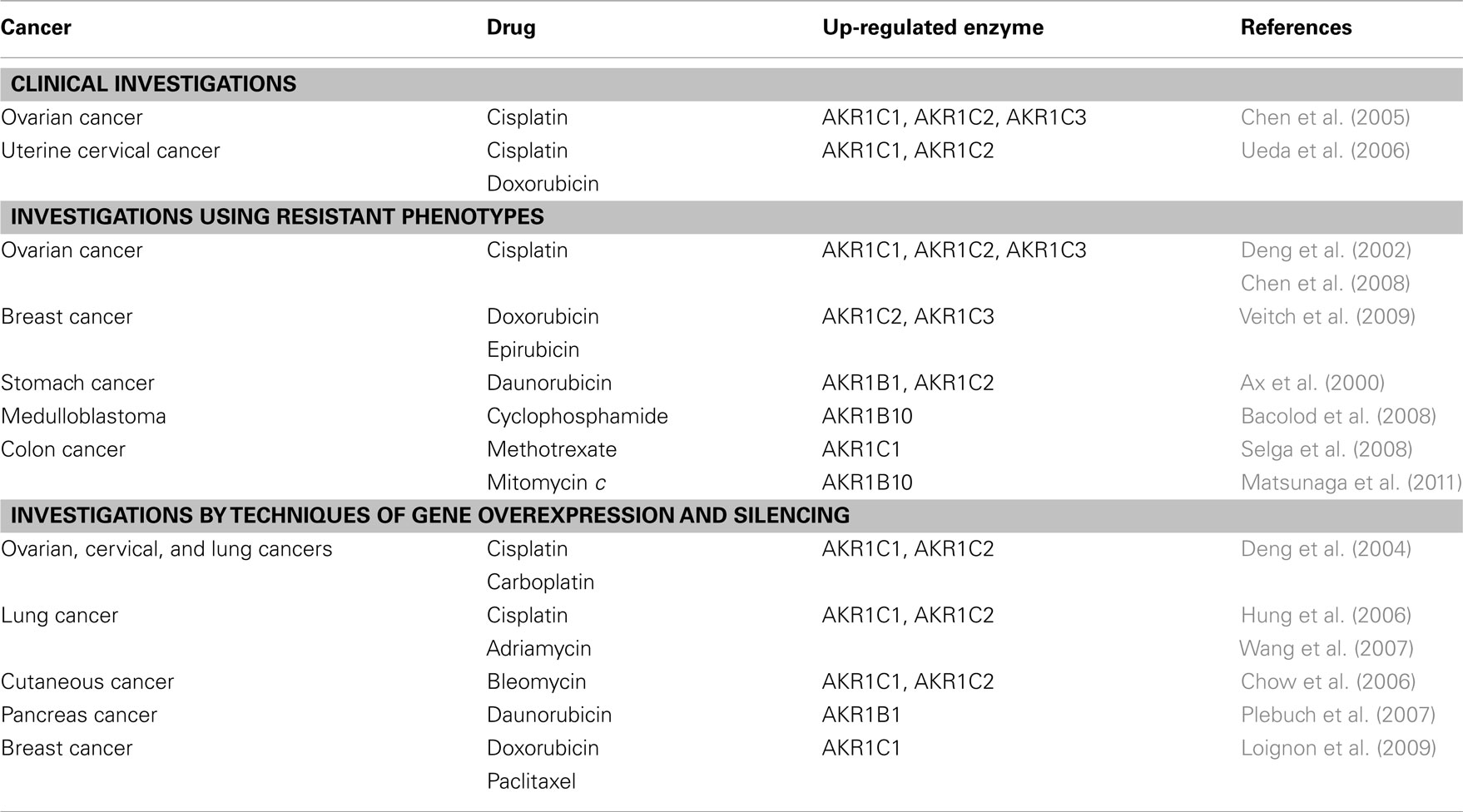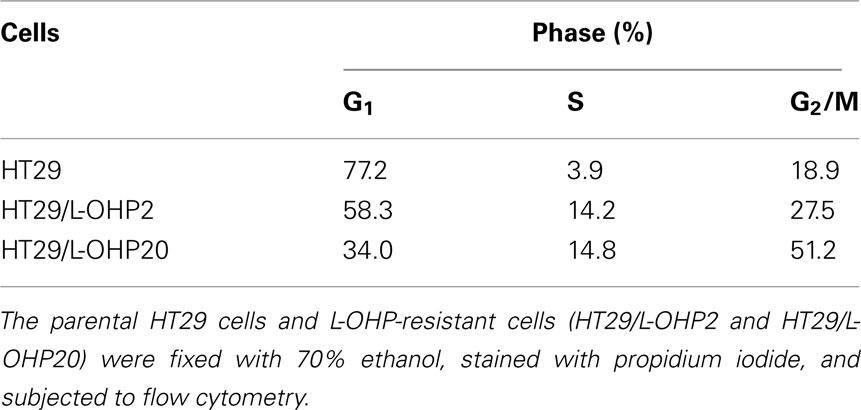- 1 Laboratory of Biochemistry, Gifu Pharmaceutical University, Gifu, Japan
- 2 Laboratory of Clinical Pharmacy, School of Pharmacy, Aichi Gakuin University, Nagoya, Japan
- 3 Monash Institute of Pharmaceutical Sciences, Monash University, Parkville, VIC, Australia
The human aldo–keto reductase AKR1B10, originally identified as an aldose reductase-like protein and human small intestine aldose reductase, is a cytosolic NADPH-dependent reductase that metabolizes a variety of endogenous compounds, such as aromatic and aliphatic aldehydes and dicarbonyl compounds, and some drug ketones. The enzyme is highly expressed in solid tumors of several tissues including lung and liver, and as such has received considerable interest as a relevant biomarker for the development of those tumors. In addition, AKR1B10 has been recently reported to be significantly up-regulated in some cancer cell lines (medulloblastoma D341 and colon cancer HT29) acquiring resistance toward chemotherapeutic agents (cyclophosphamide and mitomycin c), suggesting the validity of the enzyme as a chemoresistance marker. Although the detailed information on the AKR1B10-mediated mechanisms leading to the drug resistance process is not well understood so far, the enzyme has been proposed to be involved in functional regulations of cell proliferation and metabolism of drugs and endogenous lipids during the development of chemoresistance. This article reviews the current literature focusing mainly on expression profile and roles of AKR1B10 in the drug resistance of cancer cells. Recent developments of AKR1B10 inhibitors and their usefulness in restoring sensitivity to anticancer drugs are also reviewed.
Introduction
The aldo–keto reductase (AKR) superfamily is a rapidly growing group of NAD(P)(H)-dependent oxidoreductases that metabolize carbohydrates, steroids, prostaglandins, and other endogenous aldehydes and ketones, as well as xenobiotic compounds (http://www.med.upenn.edu/akr/). Members of this superfamily are classified into 15 families, and each family is subdivided into several subfamilies based on their amino acid sequence similarities. For examples, human aldehyde reductase and aldose reductase are named AKR1A1 and AKR1B1, respectively. Four human hydroxysteroid dehydrogenases (HSDs), 20α-HSD, type 3 3α-HSD, type 2 3α-HSD/type 5 17β-HSD, and type 1 3α-HSD, are named AKR1C1, AKR1C2, AKR1C3, and AKR1C4, respectively, and are also collectively called AKR1C isoforms. The structural, biochemical, and physiological features of 14 human AKRs have been reviewed (Matsunaga et al., 2006; Jin and Penning, 2007; Barski et al., 2008). Among them, AKR1B1 is the most extensively studied, because it is the first enzyme of the polyol pathway metabolizing glucose into sorbitol and implicated in the chronic complications of diabetes such as retinopathy, neuropathy, and nephropathy (Yabe-Nishimura, 1998). In addition, human aldose reductase-like protein AKR1B10 has been recently regarded not only as a potential diagnostic and/or prognostic marker in carcinomas and serum (Fukumoto et al., 2005; Luo et al., 2011), but also as a therapeutic target for the prevention and treatment of several types of cancer (Liu et al., 2009a). Since AKR1B10 was originally identified as an up-regulated protein in hepatocellular carcinomas (Cao et al., 1998), its overexpression is observed in other types of cancer, and its involvement in the development of resistance toward anticancer agents has been suggested. The purpose of this article is to review recent advances on roles of AKR1B10 in cancer cells and their drug resistance. In addition, we provide an update on the usefulness of AKR1B10 inhibitors in restoring sensitivity to anticancer drugs.
Properties of AKR1B10 and Its Role in Cancer Cells
AKR1B10 is a 36-kDa cytosolic reductase that is similar to AKR1B1 in both amino acid sequence identity (71%) and tertiary structure with the (α/β)8 barrel topology (Gallego et al., 2007). Like AKR1B1, AKR1B10 reduces a variety of aromatic and aliphatic aldehydes, dicarbonyl compounds, and some drug ketones using NADPH as the coenzyme (Cao et al., 1998; Martin et al., 2006; Spite et al., 2007; Baba et al., 2009; Endo et al., 2009; Zhong et al., 2009), and the reaction catalyzed by the enzyme follows an ordered bi bi mechanism with the binding of coenzyme to the free enzyme (Endo et al., 2009). However, AKR1B10 differs from AKR1B1 not only in its inability to reduce glucose and xylose (Cao et al., 1998; Crosas et al., 2003) and prostaglandin H2 (Kabututu et al., 2009), but also in its high catalytic efficiency for retinals (Crosas et al., 2003; Gallego et al., 2006), isoprenyl aldehydes (farnesal and geranylgeranial; Endo et al., 2009), and cytotoxic aldehydes (acrolein and 4-hydroxy-2-nonenal; Shen et al., 2011).
AKR1B10 reduces all-trans-retinal, 9-cis-retinal, and 13-cis-retinal to their corresponding retinols with low Km (0.6–13 μM) and high kcat/Km values (5.8–45 min−1 μM−1; Crosas et al., 2003; Gallego et al., 2006). Retinoids play a pivotal role in proliferation, differentiation, and morphogenesis of many cell types through their binding of retinoic acids to retinoic acid receptors or retinoid X receptors (Bushue and Wan, 2010; Tang and Gudas, 2011). Retinoic acids are signaling molecules for inducing cell differentiation (Tang and Gudas, 2011), and are formed by sequential oxidation of retinols (Figure 1A). AKR1B10 regulates the retinoic acid homeostasis by decreasing the cellular levels of retinoic acids through efficiently reducing retinals into retinols, and is thus thought to participate in tumor development (Crosas et al., 2003; Gallego et al., 2006, 2007; Ruiz et al., 2009).
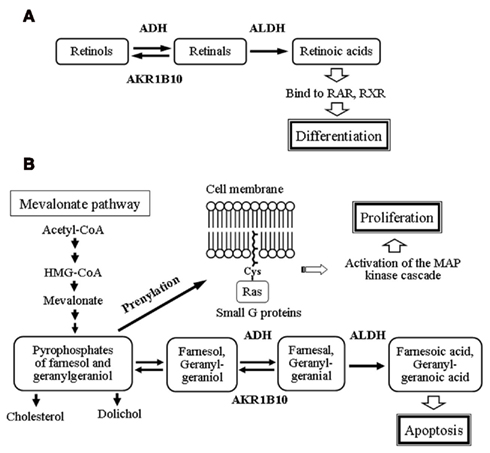
Figure 1. Metabolism of retinoids (A) and isoprenoids (B). (A) all-trans-Retinol, 13-cis-retinol, and 9-cis-retinol are oxidized to the corresponding retinoic acids through retinals by alcohol dehydrogenases (ADH) and aldehyde dehydrogenases (ALDH). Retinoic acids regulate cell function including differentiation through binding to retinoic acid receptor (RAR) and retinoid X receptor (RXR). AKR1B10 effectively reduces retinals into retinols, and is considered to promote cell proliferation by inhibiting the retinoic acid formation. (B) Farnesyl pyrophosphate, an isoprenoid intermediate of the mevalonate pathway, is converted by its dephosphorylation into farnesol, which is further oxidized into farnesal and farnesoic acid by ADH and ALDH. Geranylgeranyl pyrophosphate is similarly metabolized. The two isoprenyl pyrophosphates are used in the prenylation of small G-proteins such as Ras, leading to activation of MAP kinase cascade and resultant increase in proliferation potential of cells. AKR1B10 efficiently reduces farnesal and geranylgeranial to farnesol and geranylgeraniol, respectively, which are phosphorylated into the isoprenyl pyrophosphates. Up-regulation of AKR1B10 in carcinomas and chemoresistant cancer cells may increase the cellular levels of the two isoprenyl alcohols by reducing back their aldehyde metabolites, and then promote proliferation of the cell.
AKR1B10 also efficiently reduces farnesal and geranylgeranial into their alcohols (farnesol and geranylgeraniol) with low Km (2.3 and 0.9 μM, respectively) and high kcat/Km values (13 and 11 min−1 μM−1, respectively; Endo et al., 2009). Similar to the retinoid metabolism, the isoprenyl aldehydes are the intermediates in the metabolism of farnesol and geranylgeraniol into their carboxylic acids (farnesoic acid and geranylgeranoic acid; Endo et al., 2011), as illustrated in Figure 1B. Farnesol and geranylgeraniol are phosphorylated to their pyrophosphates, which are used for prenylation of cellular proteins including small G-proteins that are responsible for cell proliferation through activation of mitogen-activated protein (MAP) kinase cascade (Park and Beese, 1997; Sinensky, 2000). The reduction of the isoprenyl aldehydes by AKR1B10 increases the cellular levels of farnesol and geranylgeraniol, which promote protein prenylation. AKR1B10 may also participate in the tumor development by regulating isoprenoid metabolism.
In addition to its role in detoxification of cytotoxic carbonyl compounds (Shen et al., 2011), AKR1B10 promotes fatty acid and lipid synthesis by blocking the ubiquitin-dependent degradation of acetyl-CoA carboxylase α, a key enzyme in fatty acid synthesis, suggesting that the enzyme also promotes cell growth and survival through modulating lipid synthesis and membrane function (Ma et al., 2008; Wang et al., 2009). Although the following four roles of AKR1B10 in cancer cells have been proposed: (a) detoxification of cytotoxic carbonyl compounds, (b) promoting fatty acid and lipid synthesis, (c) reducing farnesal and geranylgeranial into their alcohols, and (d) reducing all-trans-retinal, 9-cis-retinal, and 13-cis-retinal to their corresponding retinols, further studies are needed to elucidate which is the key role in cellular growth and/or survival of each types of cancer described below.
Cancer-Associated Overexpression of AKR1B10
In contrast to ubiquitous distribution of AKR1B1 (Grimshaw and Mathur, 1989), AKR1B10 is highly expressed in human gastrointestinal tract and adrenal gland, but its expression levels in other tissues are low (Cao et al., 1998; Hyndman and Flynn, 1998; Fukumoto et al., 2005). Of the two AKRs, AKR1B10 is significantly up-regulated in large and small airways of healthy smokers, while it is less detected in those of healthy non-smokers (Pierrou et al., 2007; Zhang et al., 2008; Wang et al., 2010). The up-regulation of AKR1B10 is possibly due to components in tobacco smoke (Nagaraj et al., 2006; Penning and Lerman, 2008). In addition, the overexpression of AKR1B10 is reported in the following malignant tumors. In lung cancer, AKR1B10, but not AKR1B1, is overexpressed, and the incidence of its overexpression differs depending on cancer types. Fukumoto et al. (2005) first reported the overexpression of AKR1B10 in most cases of squamous cell lung carcinomas and 29% of adenocarcinomas, both of which are also associated with smoking. The finding is confirmed by subsequent studies, in which AKR1B10 overexpression is more frequently detected in smokers with squamous cell lung cancer than in non-smokers with the cancer or smokers with adenocarcinomas (Woenckhaus et al., 2006; Kim et al., 2007; Li et al., 2008; Kang et al., 2011). Hence, AKR1B10 is considered as a potential diagnostic marker of smoking-associated squamous cell lung carcinoma. AKR1B10 activates pro-carcinogenic polycyclic aromatic hydrocarbons in tobacco smoke by exhibiting dihydrodiol dehydrogenase activity (Quinn et al., 2008), suggesting a possibility that this enzyme is involved in carcinogenesis of the smoking-associated lung carcinoma. In malignant liver tumors, both levels of AKR1B1 and AKR1B10 are increased, but the overexpression frequency of AKR1B10 is higher than that of AKR1B1 (Cao et al., 1998; Scuric et al., 1998; Lee et al., 2001; Teramoto et al., 2008; Satow et al., 2010). Recent clinicopathological studies show that the expression of AKR1B10 differs depending on stages of hepatocellular carcinomas: The enzyme is significantly overexpressed in lower tumor stages with underlying cirrhosis or viral hepatitis, whereas it is down-regulated in advanced tumor stages with low-grade of differentiation (Heringlake et al., 2010; Schmitz et al., 2011). Thus, AKR1B10 may be a valuable biomarker of differentiation and proliferation of liver tumor, and play a role in early phases of hepatocarcinogenesis. The up-regulation of AKR1B10 is also reported in uterine carcinomas (Yoshitake et al., 2007), cholangiocarcinomas (Heringlake et al., 2010), early stage gastric tumor (Lee et al., 2010), and esophageal carcinogenesis (Breton et al., 2008).
The cancer-associated overexpression of AKR1B10 probably results from an adaptive response to oncogenic processes, but little is known about its gene regulation. Liu et al. (2009b) characterized the promoter region of the AKR1B10 gene, which includes multiple putative oncogenic and tumor suppressor protein binding sites, including the transcriptional factors c-Ets-1 and C/EBP, the repressor protein p53, and the AP-1 oncogene. Nishinaka et al. (2011) identified several putative regulatory motifs, such as AP-1, NF-κB, and antioxidant response element, in a −3282 bp of the 5′-flanking region and 5′-untranslation region of AKR1B10 gene, and also suggest a possibility that a complex polymorphic microsatellite in this region is implicated in the enzyme induction in response to certain stimuli such as carcinogens. Further investigations on the regulatory mechanisms of AKR1B10 gene expression are needed to elucidate the significance of its induction in cancer cells.
Alteration in Expression Levels of AKRs in Chemoresistant Cells
Chemotherapy is commonly utilized as a therapeutic approach for many cancers. However, one of major problems occurring during the therapy is the intrinsic or drug resistance of the cancer cells, which leads to malignant transformation and metastasis of tumors. Previous studies proposed several candidate molecules that play key roles in the mechanisms of chemoresistance. One of the most recognized candidates is an efflux transporter P-glycoprotein. As P-glycoprotein is called multidrug resistance protein, its aberrant expression decreases the metabolic clearance of the drugs through shortening its residence time in the cells (Higgins, 2007). The chemoresistance of the cancer cells is also provoked by high expression of an inhibitor of apoptosis (IAP) family members, such as c-IAP1 (Yang and Li, 2000; Notarbartolo et al., 2004), which is considered to inhibit apoptotic cell death elicited by some chemotherapeutics, such as cisplatin and doxorubicin, through directly interacting with caspases and then abolishing their pro-apoptotic actions (Vaziri et al., 2003; Tirrò et al., 2006). Other resistance-related factors are growth factor receptors and the ubiquitin–proteasome system. Binding of ligands to fibroblast growth factor receptor-1 and -3 activates both signalings of MAP kinase and phosphoinositide 3-kinase (Roidl et al., 2009; Tomlinson et al., 2012). Therefore, overexpression of the growth factor receptors may enhance capacities of resistant cells to proliferate, and protect from fatal damage induced by anticancer drugs. The ubiquitin–proteasome system, a large multi-subunit complex that cleaves damaged and misfolded proteins, is thought to be activated with cancer chemoresistance. The involvement of proteasomes in the chemoresistance is obvious from data that treatment with proteasome inhibitors MG132 and bortezomib induces multidrug resistance-associated protein 2 in human colon cancers (Loeffler-Ragg et al., 2009; Ebert et al., 2011). In addition, the proteasome modulates the expression of transcription factors, such as NF-κB, p53, c-Jun, and c-Fos, that participate in the mechanisms of cell proliferation and differentiation (Cory and Cory, 2002; Li et al., 2007). Moreover, the ubiquitin–proteasome system appears to regulate cellular susceptibility to death by controlling the balance between pro-apoptotic caspases and anti-apoptotic Bcl and IAPs (Almond and Cohen, 2002).
A growing body of evidence implicates some members of the AKR superfamily as new candidates that are involved in acquisition of chemoresistance. Among the members, AKR1B1, AKR1B10, and three AKR1C isoforms (AKR1C1, AKR1C2, and AKR1C3) are reported to be up-regulated in several cancers exposed to anticancer drugs (Table 1). Although clinical studies are few, Chen et al. (2005) showed that the three AKR1C isoforms are up-regulated in ovarian cancers, in which their overexpression extents in cases resistant to cisplatin are much higher than those in cisplatin-sensitive ones. Ueda et al. (2006) also reported that AKR1C1/1C2 are highly expressed in uterine cervical cancer with papillomavirus infection, and suggests that their high expression is closely associated with drug resistance to cisplatin and anthracyclines.
Studies using the resistant phenotypes of cancer cells prepared by exposure to anticancer drugs provided some informative results concerning the relationship of the AKR expression with the drug resistance. The overexpression of the three AKR1C isoforms due to cisplatin resistance is observed in resistant phenotypes of ovarian cancer cells (Deng et al., 2002; Chen et al., 2005, 2008). In the resistance to anthracyclines, resistance of breast tumor cells to doxorubicin and epirubicin increases the expression levels of AKR1C2 and AKR1C3 (Veitch et al., 2009), and daunorubicin-resistant variant cells of stomach cancer highly express the mRNAs for AKR1B1 and AKR1C2 (Ax et al., 2000). In the resistance to other agents, magnitude of resistance to cyclophosphamide (in medulloblastoma) and methotrexate (in colon cancer cells) is correlated with up-regulation of AKR1B10 and AKR1C1, respectively (Bacolod et al., 2008; Selga et al., 2008). We recently found high expression of AKR1B10 in mitomycin c-resistant phenotypes of colon cancer HT29 cells (Matsunaga et al., 2011). In addition to the studies using the resistant phenotypes, cell-based experimental techniques of transgenesis and small RNA interference elucidate crucial roles of the five enzymes in chemoresistance of cells derived from various cancers, as listed in Table 1.
Gain of resistance to platinum drugs, cisplatin, and carboplatin, increases the expression levels of AKR1C1 and AKR1C2 in cells derived from several cancers of ovary, cervix, lung, and germ cell (Deng et al., 2004). However, the effect of resistance to platinum drugs on the expression of AKRs in colon cancer has not been studied. To date, oxaliplatin (L-OHP), a third generation platinum analog, is used for treatment of colon cancer, especially the metastatic colorectal cancer. Our recent data on the effect of L-OHP on the expression of AKRs in colon cancer HT29 cells are shown below. We established low-grade (HT29/L-OHP2) and high-grade (HT29/L-OHP20) resistant phenotypes, which show resistance to the drug concentrations of 2 and 20 μM, respectively. The parental cells express AKR1C1, AKR1C2, AKR1C3, and AKR1B10, but not AKR1B1, which is not detected even in the resistant phenotypes. In the low-grade resistant cells, only AKR1B10 is highly expressed in contrast to no apparent changes in the levels of AKR1C1/1C2 and AKR1C3 (Figure 2). In contrast, the levels of all AKRs are remarkably low in the high-grade resistant cells. Since the HT29/L-OHP20 cells show 10-fold higher 26S proteasome activity than the control cells, it is a persuasive argument that the facilitation of the proteasome function is involved in the down-regulation of the AKRs except for AKR1B1.
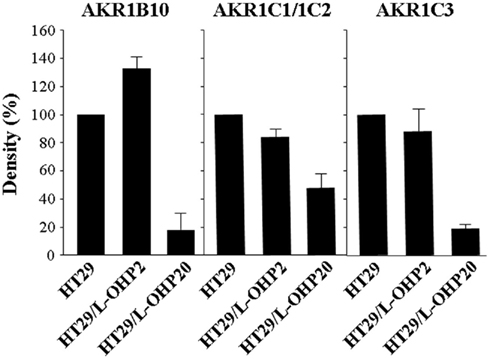
Figure 2. Expression levels of AKRs in parental and L-OHP-resistant HT29 cells. The cells were grown in Dulbecco’s modified Eagle’s medium supplemented with 10% fetal bovine serum and antibiotics. The two L-OHP-resistant cells HT29/L-OHP2 and HT29/L-OHP20 were prepared by exposing of the parental cells to incremental stepwise concentrations (0.05–2 and 20 μM, respectively) of L-OHP. The amounts of AKR1B10, AKR1C1/1C2, and AKR1C3 in the cell extracts were analyzed by Western blotting using the antibodies against the enzymes (Matsunaga et al., 2011). The density of the immunoreactive band is normalized to that in the parental cells (taken as 100%), and expressed as the mean ± SD of three independent experiments. AKR1C1/1C2: total amount of AKR1C1 and AKR1C2 detected by the antibody cross-react with the two enzymes.
A well accepted mechanism for induction of AKR1B10, AKR1C1, AKR1C2, and AKR1C3 is a nuclear factor erythroid 2-related factor 2 (Nrf2)-Kelch-like ECH-associated protein 1 (Keap1) system (Penning and Lerman, 2008; MacLeod et al., 2009; Nishinaka et al., 2011; Agyeman et al., 2012). Under normal conditions, the transcription factor Nrf2 tightly binds to Keap1 in the cytosol and is degraded by the ubiquitin–proteasome system (Lau et al., 2008). Nrf2 is dissociated from Keap1 in response to various stimuli including reactive oxygen species (ROS; De Vries et al., 2008) and electrophiles (Levonen et al., 2004), translocates into the nuclei, and binds to antioxidant response element in genes to transcriptionally induce proteins including the above AKRs. Recently, Jiang et al. (2010) showed a relationship between abnormal activation of Nrf2 in type II endometrial cancer and the development of chemoresistance. This is supported by findings that the overexpression and knockdown of Nrf2 result in increase and decrease, respectively, in chemoresistance of some types of cancer cells (Cho et al., 2008; Wang et al., 2008; Shim et al., 2009). Recent studies proposed two theories as the reasonable mechanistic base for hyperactivation of Nrf2 in the cancer cells resistant to chemotherapy. Loignon et al. (2009) showed that the Nrf2 hyperactivation is due to down-regulation of Cullin 3 ubiquitin E3 ligase, an adaptor protein that specifically targets Nrf2 for degradation in the ubiquitin–proteasome system, finally leading to sensitization to doxorubicin and paclitaxel. In addition, mutations in Nrf2/Keap1 complex, especially in Keap1, to lose the Nrf2–Keap1 interaction are identified in cancer cell lines showing chemoresistance (Singh et al., 2006; Shibata et al., 2008). Thus, the Nrf2 activation is considered as a crucial event in the development of chemoresistance. In contrast, our data, together with studies listed in Table 1, clearly indicate that expression patterns of the Nrf2-related genes AKR1B10, AKR1C1/1C2, and AKR1C3 differ depending on both cell types and anticancer drugs involved in resistance induction. Hence, the different expression patterns of AKRs in chemoresistant cancers may result from complex mechanisms that regulate the synthesis and degradation of AKR proteins.
Possible Roles of AKR1B10 in Chemoresistant Cancer Cells
Metabolism of Anticancer Drugs
AKR1B10 converts daunorubicin and idarubicin into less toxic forms daunorubicinol and idarubicinol, respectively, by reducing C13 ketone groups, with Km values ranging from 0.4 to 10 mM (Martin et al., 2006; Balendiran, 2009; Balendiran et al., 2009; Bains et al., 2010; Zhong et al., 2011). The enzyme also reduces doxorubicin and epirubicin albeit at lower rates (Bains et al., 2010; Zhong et al., 2011). The artificial overexpression and inhibition of AKR1B10 in 293 T cells result in decrease and increase, respectively, in sensitivity to daunorubicin and idarubicin (Zhong et al., 2011). These findings suggest that the AKR1B10 up-regulation is responsible for the resistance to the anthracyclines. In addition, AKR1B10 is suggested to be involved in acquisition of the resistance of medulloblastoma to cyclophosphamide through a deactivation of a reactive cyclophosphamide metabolite aldophosphamide (Bacolod et al., 2008). Furthermore, we recently found a significant increase in NADPH-linked reductase activity toward mitomycin c in the drug-resistant HT29 cells (unpublished data), in which AKR1B10 is significantly overexpressed (Matsunaga et al., 2011). This may imply that the involvement of AKR1B10 in the mitomycin c resistance is in part due to its ability to metabolize this drug.
Cell Proliferation
AKR1B10 is suggested to enhance cancer cell proliferation (Zu et al., 2009), and its gene silencing suppresses growth of human colon cancer HCT-8 cells (Yan et al., 2007). As shown in Figure 3, overexpression of AKR1B10 in human leukemic monocyte lymphoma U937 cells significantly increases the cell proliferation, which is abrogated by the addition of a potent AKR1B10 inhibitor (Z)-2-(4-methoxyphenylimino)-7-hydroxy-N-(pyridine-2-yl)-2H-chromene-3-carboxamide (PHPC; Endo et al., 2010a). These findings predict the involvement of AKR1B10 in proliferative potential of many cancer cells, which may be also related to its overexpression in several cancer lesions (as mentioned in Cancer-Associated Overexpression of AKR1B10).
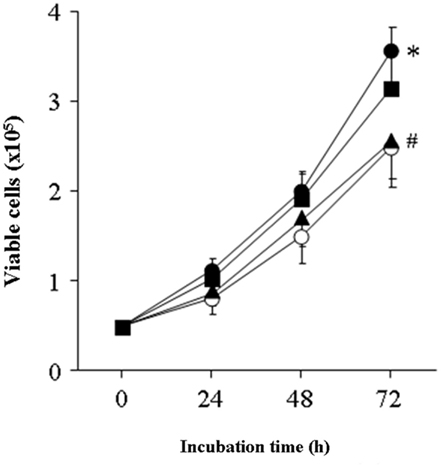
Figure 3. Overexpression of AKR1B10 elevates proliferation potential in U937 cells. U937 cells were cultured in Dulbecco’s modified Eagle’s medium supplemented with 10% fetal bovine serum and antibiotics, and transfected with the expression vector harboring the AKR1B10 cDNA as described previously (Endo et al., 2009). The cell expressed AKR1B10, which was not detected in the control cells transfected with the empty vector. The cells were seeded at a density of 5 × 104 cells/well into a 24-well multiplate, and cultured for 24, 48, or 72 h after addition of 0 (●), 5 (■), or 20 μM (▲) of the AKR1B10 inhibitor, PHPC. The number of viable cells was evaluated by the trypan blue-dye exclusion method, and is expressed as the mean ± SD of three independent experiments. Since no significant effect of PHPC on growth of the control cells was observed, only the proliferation of the control cells without PHPC (○) is depicted. *Significant difference (p < 0.05) for the overexpressing cells without PHPC (●) from the control cells (○). #Significant difference for the overexpressing cells with 20 μM PHPC (▲) from those without the inhibitor (●).
The acquisition of multidrug resistance in a variety of cancer cells has been shown to decrease tumorigenicity and prolong doubling time due to a G2/M phase elongation (O’Loughlin et al., 2000; De Angelis et al., 2006). However, to our knowledge, there have been no reports on a relationship between AKR1B10 expression and proliferative potential in chemoresistant cancer cells. When the two L-OHP-resistant and the parental HT29 cells that are described in Figure 2 are compared with respect to proliferation rate and DNA replication potential, there is a strong correlation between the two potentials and AKR1B10 level expressed in the cells. As shown in Figure 4A, the parental cells exhibit more rapid growth than HT29/L-OHP20 cells (with much lower level of AKR1B10 than the parental cells). The involvement of AKR1B10 in the proliferative potential is evidenced by significant suppression of the proliferation of the parental cells, but not HT29/L-OHP20 cells, by the AKR1B10 inhibitor PHPC. In the DNA replication potential (Figure 4B), the order of 5-bromo-2′-deoxyuridine (BrdU) uptake is HT29/L-OHP2 cells > the parental cells > HT29/L-OHP20 cells, which also correlates with the expression levels of AKR1B10 shown in Figure 2. Flow cytometry analysis of the resistant cells reveals that shortening of G1 phase and G2/M phase elongation are associated with the magnitude of the L-OHP resistance (Table 2), but not with the AKR1B10 expression. Thus, AKR1B10 may participate in the proliferative mechanism of L-OHP-resistant colon cancer cells, although it affects the cell cycle less.
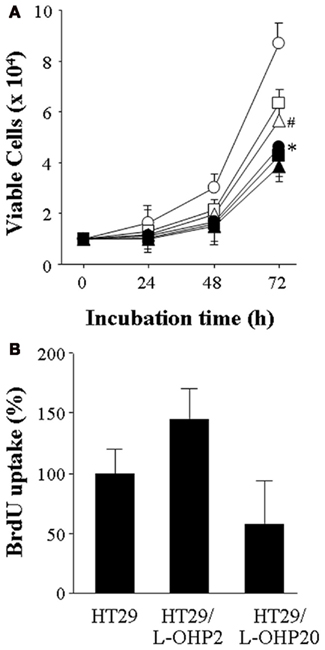
Figure 4. Alteration in proliferation (A) and DNA replication potential (B) of HT29 cells by gain of resistance to L-OHP. (A) HT29/L-OHP20 (closed symbols) and the parental cells (open symbols) were cultured in the presence of 0 (circles), 5 (squares), or 20 μM PHPC (triangles), and their viable cell numbers were evaluated as described in Figure 2. Significant difference (p < 0.05) for HT29/L-OHP20 cells with 0 μM (●)* or the parental cells with 20 μM PHPC (Δ)# from the parental cells without PHPC (○). (B) Uptake of 5-bromo-2′-deoxyuridine (BrdU) into DNAs in the parental (HT29) and resistant (HT29/L-OHP2 and HT29/L-OHP20) cells was measured using a cell proliferation ELISA biotrak system (GE healthcare, Buckinghamshire, UK). Value is normalized to that in the parental cells (taken as 100%), and expressed as the mean ± SD of three independent experiments.
As mentioned in its roles in cancer cells, AKR1B10 is thought to participate in tumor development by detoxifying cytotoxic aldehydes and modulating the retinoic acid homeostasis, isoprenoid metabolism, and lipid metabolism. In contrast, little is known about the roles of the up-regulated enzyme in chemoresistant cancer cells. We show evidence that the modulation of the isoprenoid metabolism by AKR1B10 is involved in proliferative capacity of the L-OHP-resistant HT29 cells (Figures 5 and 6). In the parental HT29 cells (Figures 5A,B), the treatments with low concentrations (1–2 μM) of farnesol and farnesal facilitate the cell growth, although their high doses (>5 μM) lower the viable cell numbers as reported by Joo and Jetten (2010). The facilitation of cell growth by the isoprenoids is further potentiated by the addition of 4-hydroxyacetophenone, an inhibitor of aldehyde dehydrogenase 3A2 that catalyzes oxidation of farnesal into farnesoic acid (Endo et al., 2011). In the analysis of DNA replication potential (Figure 6), the BrdU uptake of the parental cells is elevated by treating with farnesol or farnesal plus 4-hydroxyacetophenone. The two treatments also enhance the DNA replication potential of resistant HT29/L-OHP2 cells (which is originally high due to the overexpression of AKR1B10), but has no stimulatory effect on HT29/L-OHP20 cells with low AKR1B10 expression. In addition, activation of MEK1/2, also known as MAP kinase kinase, is observed in HT29/L-OHP2 cells treated with 1 μM farnesol or farnesal (data not shown). These results may indicate that the AKR1B10-mediated reduction of farnesal into farnesol not only lessens colon cancer cell damage induced by farnesoic acid, but also promotes the cell proliferation, probably due to protein farnesylation and activation of MAP kinase signaling as mentioned above (Figure 1B). Thus, AKR1B10 overexpressed in the resistant HT29/L-OHP2 cells participates in cell proliferation at least by modulating the isoprenoid metabolism.
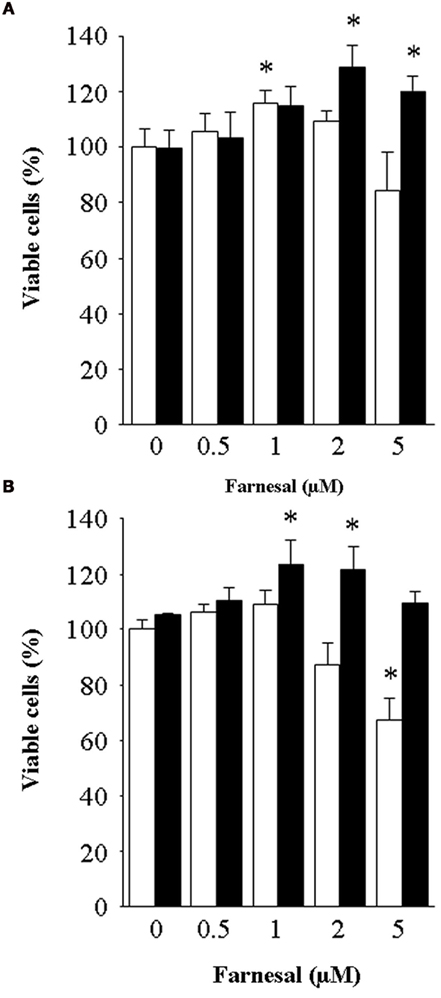
Figure 5. Facilitation of proliferation potential of HT29 cells by treatment with farnesol (A) and farnesal (B). HT29 cells were pretreated for 2 h without (□) or with 25 μM 4-hydroxyacetophenone (■), and then treated for 48 h with the indicated concentrations of farnesol or farnesal. The viable cell number was evaluated as noted in Figure 4. Value is normalized to those in the control cells incubated without both isoprenoids and 4-hydroxyacetophenone, and expressed as the mean ± SD of three independent experiments. *Significant difference (p < 0.05) from the control cells.
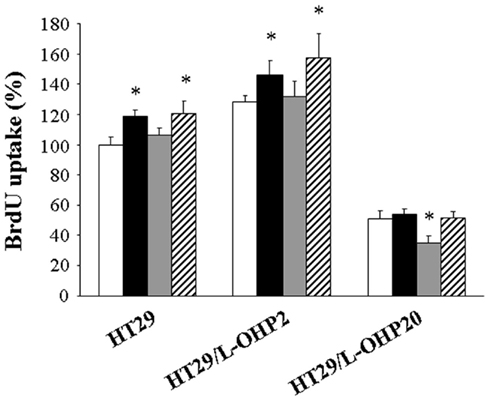
Figure 6. Isoprenoids promote DNA replication in L-OHP-resistant HT29 cells. The parental HT29 cells and resistant HT29/L-OHP2 and HT29/L-OHP20 cells were treated for 48 h without (□) or with 1 μM farnesol (■) or 1 μM farnesal ( ), and the BrdU uptake was measured in the cells. The cells were also pretreated for 2 h with 25 μM 4-hydroxyacetophenone prior to treating with 1 μM farnesal (
), and the BrdU uptake was measured in the cells. The cells were also pretreated for 2 h with 25 μM 4-hydroxyacetophenone prior to treating with 1 μM farnesal ( ). Value is normalized to that in the control HT29 cells incubated without both isoprenoids and 4-hydroxyacetophenone, and expressed as the mean ± SD of three independent experiments. *Significant difference (p < 0.05) from the control cells.
). Value is normalized to that in the control HT29 cells incubated without both isoprenoids and 4-hydroxyacetophenone, and expressed as the mean ± SD of three independent experiments. *Significant difference (p < 0.05) from the control cells.
Antioxidant Capacity
Treatment of cancer cells with some chemotherapeutic agents generates ROS, which modify biomolecules, nucleic acids, proteins and lipids, and consequently forms highly reactive and toxic carbonyl compounds, such as 4-hydroxy-2-nonenal and 4-oxo-2-nonenal. In vitro enzyme assay showed that AKR1B10 effectively reduces these lipid peroxidation-derived aldehydes into their corresponding alcohols (Liu et al., 2009a; Martin and Maser, 2009; Wang et al., 2009; Shen et al., 2011), of which metabolism of HNE by AKR1B10 is also verified in cell-based experiments (Zhong et al., 2009; Shen et al., 2011). Knockdown of AKR1B10 gene by small interference RNAs sensitizes colon cancer HCT-8 cells to acrolein and crotonaldehyde (Yan et al., 2007). While many studies support the detoxification of lipid peroxidation-derived carbonyl compounds as a role of AKR1B10 in tumor development, there is only one study concerning this role in chemoresistance. Mitomycin c produces ROS by its redox cycling, and the detoxification of lipid aldehydes by AKR1B10 is reported to be a major molecular basis for gaining of the mitomycin c resistance of HT29 cells (Matsunaga et al., 2011). It is possible that AKR1B10 exert this role in cancer cells resistant to other anticancer drugs, such as bleomycin (Khadir et al., 1999) and paclitaxel (Alexandre et al., 2007), that are known to produce ROS.
Reversal of Chemoresistance by AKR1B10 Inhibitors
AKR1B10 is considered as a key factor responsible for carcinogenesis and chemoresistance as mentioned above. The enzyme also exhibits different substrate profiles from AKR1B1, despite their high structural homology. Therefore, development of potent inhibitors specific to AKR1B10 is prerequisite for remediation of the enzyme-related diseases. Recently, cyclopentenone prostaglandin A1 has been reported to be an AKR1B10 inhibitor, which covalently binds to Cys299 near the active site of the enzyme (Díez-Dacal et al., 2011). Interestingly, the inhibitor seems to increase sensitivity of lung cancer A549 cells to doxorubicin. Another study showed that polyphenol butein potently inhibits DL-glyceraldehyde reductase activity of AKR1B10, with an IC50 value of 1.47 μM (Song et al., 2010). We previously reported steroid hormones, bile acids, and their metabolites as endogenous AKR inhibitors (Endo et al., 2009). More recently, by means of natural products-based comprehensive analyses and in silico screening approaches we have found curcumin derivatives (Matsunaga et al., 2009), a fluorone derivative (Zhao et al., 2010), chromene derivatives (Endo et al., 2010a), non-steroidal antiinflammatory agents (Endo et al., 2010b), and oleanolic acid (Takemura et al., 2011) to be potent and/or specific AKR1B10 inhibitors. Structures and IC50 values of representative AKR1B10 inhibitors are shown in Figure 7. Among the inhibitors, a chromene derivative, PHPC, is the most potent competitive inhibitor with an IC50 value of 6 nM, although the AKR1B10 selectivity versus AKR1B1 is approximately twofold. In contrast, oleanolic acid inhibits AKR1B10 with the highest selectivity ratio of 1370. The crystal structure of the enzyme-NADP+–tolrestat ternary complex reveals that the inhibitor binds to the active site of the enzyme (Gallego et al., 2006). Like tolrestat (Endo et al., 2009), the above inhibitors are kinetically competitive inhibitors, suggesting that they also bind to the same site as that for tolrestat. Figure 8 shows the oleanolic acid-docked model, on which tolrestat of the crystal structure was superimposed. The two inhibitors occupied the substrate-binding site of the enzyme, in which the 3β-hydroxy group of oleanolic acid and carboxyl group of tolrestat are in close proximity to catalytically important residues (Tyr49 and His111). There are differences in the orientation of the other parts of the two molecules, and two residues (Val301 and Gln303) are suggested to be key determinants of the inhibitory selectivity of oleanolic acid for AKR1B10 over AKR1B1 (Takemura et al., 2011). The cell-based approaches show that the two inhibitors (PHPC and oleanolic acid) remarkably reversed the mitomycin c resistance of HT29 cells (Matsunaga et al., 2011; Takemura et al., 2011). Thus, potent and selective AKR1B10 inhibitor would be useful for adjuvant medicine to subdue the development of cancer resistance to chemotherapy.
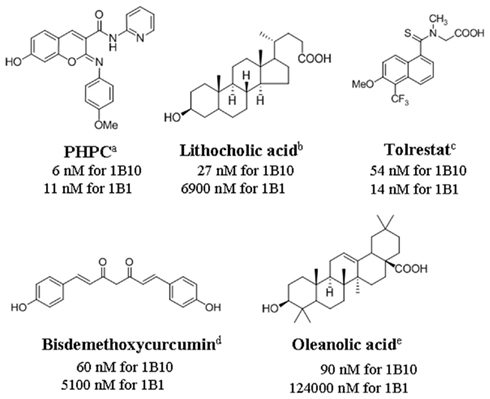
Figure 7. Structures and IC50 values of representative AKR1B10 inhibitors. The IC50 values for AKR1B10 (1B10) and AKR1B1 (1B1) are taken from a Endo et al. (2010a), b Endo et al. (2009), c Endo et al. (2010b), d Matsunaga et al. (2009), e Takemura et al. (2011).
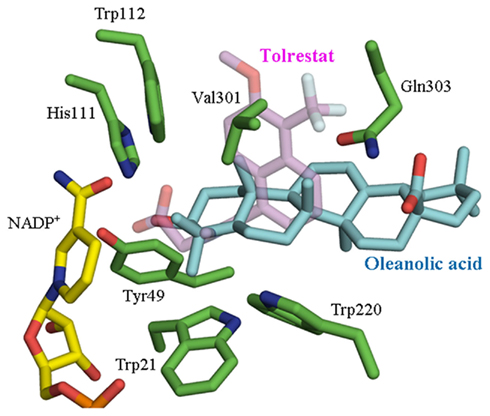
Figure 8. Comparison of binding modes of oleanolic acid and tolrestat in the AKR1B10–NADP+ complex. The oleanolic acid-docked model (Takemura et al., 2011) is superimposed on the crystal structure of tolrestat–NADP+–AKR1B10 ternary complex (Gallego et al., 2007), and only tolrestat (pink) is shown with residues involving in the binding to oleanolic acid (sky-blue).
Concluding Remarks
It is commonly assumed that chemoresistance of cancer cells is induced with extraordinary enhancement of four capacities (1) to metabolize anticancer drugs into their harmless forms, (2) to protect from damage evoked by them, (3) to secrete them into extracellular space and (4) to grow in order to overcome their lethal effects through activation of growth factor signaling pathways, of which, AKR1B10 is involved in the three capacities (1, 2, and 4) as mentioned above. It is recently shown that the AKR1B10 activity is controlled by exchange of thiol–disulfide in Cys residues that are attacked by reactive radicals (Shen et al., 2010). In addition, analyses of the single-nucleotide polymorphism of AKR1B10 disclosed the presence of three kinds of mutations (P87S, M286T, and N313D), which impair reductase activity of the enzyme toward (1S)-1-indanol, albeit to a lesser degree (Bains et al., 2010). Thus, it is speculated that the alteration in expression and/or activity of AKR1B10 significantly influences on the manifestation of drug resistance and malignant progression. As mentioned above, there is limited direct evidence in the literature regarding expression profiles of the enzyme in cancers with chemoresistance. Additionally, definite roles of other four AKRs in chemoresistant cells have been not fully understood. Further studies are therefore needed to monitor the expression of AKRs in various kinds of cancers refractory to drugs.
Conflict of Interest Statement
The authors declare that the research was conducted in the absence of any commercial or financial relationships that could be construed as a potential conflict of interest.
References
Agyeman, A. S., Chaerkady, R., Shaw, P. G., Davidson, N. E., Visvanathan, K., Pandey, A., and Kensler, T. W. (2012). Transcriptomic and proteomic profiling of KEAP1 disrupted and sulforaphane-treated human breast epithelial cells reveals common expression profiles. Breast Cancer Res. Treat. PMID: 21597922. [Epub ahead of print].
Alexandre, J., Hu, Y., Lu, W., Pelicano, H., and Huang, P. (2007). Novel action of paclitaxel against cancer cells: bystander effect mediated by reactive oxygen species. Cancer Res. 67, 3512–3517.
Almond, J. B., and Cohen, G. M. (2002). The proteasome: a novel target for cancer chemotherapy. Leukemia 16, 433–443.
Ax, W., Soldan, M., Koch, L., and Maser, E. (2000). Development of daunorubicin resistance in tumour cells by induction of carbonyl reduction. Biochem. Pharmacol. 59, 293–300.
Baba, S. P., Barski, O. A., Ahmed, Y., O’Toole, T. E., Conklin, D. J., Bhatnagar, A., and Srivastava, S. (2009). Reductive metabolism of AGE precursors: a metabolic route for preventing AGE accumulation in cardiovascular tissue. Diabetes 58, 2486–2497.
Bacolod, M. D., Lin, S. M., Johnson, S. P., Bullock, N. S., Colvin, M., Bigner, D. D., and Friedman, H. S. (2008). The gene expression profiles of medulloblastoma cell lines resistant to preactivated cyclophosphamide. Curr. Cancer Drug Targets 8, 172–179.
Bains, O. S., Grigliatti, T. A., Reid, R. E., and Riggs, K. W. (2010). Naturally occurring variants of human aldo-keto reductases with reduced in vitro metabolism of daunorubicin and doxorubicin. J. Pharmacol. Exp. Ther. 335, 533–545.
Balendiran, G. K. (2009). Fibrates in the chemical action of daunorubicin. Curr. Cancer Drug Targets 9, 366–369.
Balendiran, G. K., Martin, H. J., El-Hawari, Y., and Maser, E. (2009). Cancer biomarker AKR1B10 and carbonyl metabolism. Chem. Biol. Interact. 178, 134–137.
Barski, O. A., Tipparaju, S. M., and Bhatnagar, A. (2008). The aldo-keto reductase superfamily and its role in drug metabolism and detoxification. Drug Metab. Rev. 40, 553–624.
Breton, J., Gage, M. C., Hay, A. W., Keen, J. N., Wild, C. P., Donnellan, C., Findlay, J. B., and Hardie, L. J. (2008). Proteomic screening of a cell line model of esophageal carcinogenesis identifies cathepsin D and aldo-keto reductase 1C2 and 1B10 dysregulation in Barrett’s esophagus and esophageal adenocarcinoma. J. Proteome Res. 7, 1953–1962.
Bushue, N., and Wan, Y. J. (2010). Retinoid pathway and cancer therapeutics. Adv. Drug Deliv. Rev. 62, 1285–1298.
Cao, D., Fan, S. T., and Chung, S. S. (1998). Identification and characterization of a novel human aldose reductase-like gene. J. Biol. Chem. 273, 11429–11435.
Chen, J., Adikari, M., Pallai, R., Parekh, H. K., and Simpkins, H. (2008). Dihydrodiol dehydrogenases regulate the generation of reactive oxygen species and the development of cisplatin resistance in human ovarian carcinoma cells. Cancer Chemother. Pharmacol. 61, 979–987.
Chen, Y. J., Yuan, C. C., Chow, K. C., Wang, P. H., Lai, C. R., Yen, M. S., and Wang, L. S. (2005). Overexpression of dihydrodiol dehydrogenase is associated with cisplatin-based chemotherapy resistance in ovarian cancer patients. Gynecol. Oncol. 97, 110–117.
Cho, J. M., Manandhar, S., Lee, H. R., Park, H. M., and Kwak, M. K. (2008). Role of the Nrf2-antioxidant system in cytotoxicity mediated by anticancer cisplatin: implication to cancer cell resistance. Cancer Lett. 260, 96–108.
Chow, K. C., Lu, M. P., and Wu, M. T. (2006). Expression of dihydrodiol dehydrogenase plays important roles in apoptosis- and drug-resistance of A431 squamous cell carcinoma. J. Dermatol. Sci. 41, 205–212.
Cory, A. H., and Cory, J. G. (2002). Lactacystin, a proteasome inhibitor, potentiates the apoptotic effect of parthenolide, an inhibitor of NFκB activation, on drug-resistant mouse leukemia L1210 cells. Anticancer Res. 22, 3805–3809.
Crosas, B., Hyndman, D. J., Gallego, O., Martras, S., Parés, X., Flynn, T. G., and Farrés, J. (2003). Human aldose reductase and human small intestine aldose reductase are efficient retinal reductases: consequences for retinoid metabolism. Biochem. J. 373, 973–979.
De Angelis, P. M., Svendsrud, D. H., Kravik, K. L., and Stokke, T. (2006). Cellular response to 5-fluorouracil (5-FU) in 5-FU-resistant colon cancer cell lines during treatment and recovery. Mol. Cancer 5, 20.
De Vries, H. E., Witte, M., Hondius, D., Rozemuller, A. J., Drukarch, B., Hoozemans, J., and van Horssen, J. (2008). Nrf2-induced antioxidant protection: a promising target to counteract ROS-mediated damage in neurodegenerative disease? Free Radic. Biol. Med. 45, 1375–1383.
Deng, H. B., Adikari, M., Parekh, H. K., and Simpkins, H. (2004). Ubiquitous induction of resistance to platinum drugs in human ovarian, cervical, germ-cell and lung carcinoma tumor cells overexpressing isoforms 1 and 2 of dihydrodiol dehydrogenase. Cancer Chemother. Pharmacol. 54, 301–307.
Deng, H. B., Parekh, H. K., Chow, K. C., and Simpkins, H. (2002). Increased expression of dihydrodiol dehydrogenase induces resistance to cisplatin in human ovarian carcinoma cells. J. Biol. Chem. 277, 15035–15043.
Díez-Dacal, B., Gayarre, J., Gharbi, S., Timms, J. F., Coderch, C., Gago, F., and Pérez-Sala, D. (2011). Identification of aldo-keto reductase AKR1B10 as a selective target for modification and inhibition by prostaglandin A1: implications for antitumoral activity. Cancer Res. 71, 4161–4171.
Ebert, B., Kisiela, M., Wsól, V., and Maser, E. (2011). Proteasome inhibitors MG-132 and bortezomib induce AKR1C1, AKR1C3, AKR1B1, and AKR1B10 in human colon cancer cell lines SW-480 and HT-29. Chem. Biol. Interact. 191, 239–249.
Endo, S., Matsunaga, T., Kuwata, K., Zhao, H. T., El-Kabbani, O., Kitade, Y., and Hara, A. (2010a). Chromene-3-carboxamide derivatives discovered from virtual screening as potent inhibitors of the tumour maker, AKR1B10. Bioorg. Med. Chem. 18, 2485–2490.
Endo, S., Matsunaga, T., Soda, M., Tajima, K., Zhao, H. T., El-Kabbani, O., and Hara, A. (2010b). Selective inhibition of the tumor marker AKR1B10 by antiinflammatory N-phenylanthranilic acids and glycyrrhetic acid. Biol. Pharm. Bull. 33, 886–890.
Endo, S., Matsunaga, T., Mamiya, H., Ohta, C., Soda, M., Kitade, Y., Tajima, K., Zhao, H. T., El-Kabbani, O., and Hara, A. (2009). Kinetic studies of AKR1B10, human aldose reductase-like protein: endogenous substrates and inhibition by steroids. Arch. Biochem. Biophys. 487, 1–9.
Endo, S., Matsunaga, T., Ohta, C., Soda, M., Kanamori, A., Kitade, Y., Ohno, S., Tajima, K., El-Kabbani, O., and Hara, A. (2011). Roles of rat and human aldo-keto reductases in metabolism of farnesol and geranylgeraniol. Chem. Biol. Interact. 191, 261–268.
Fukumoto, S., Yamauchi, N., Moriguchi, H., Hippo, Y., Watanabe, A., Shibahara, J., Taniguchi, H., Ishikawa, S., Ito, H., Yamamoto, S., Iwanari, H., Hironaka, M., Ishikawa, Y., Niki, T., Sohara, Y., Kodama, T., Nishimura, M., Fukayama, M., Dosaka-Akita, H., and Aburatani, H. (2005). Overexpression of the aldo-keto reductase family protein AKR1B10 is highly correlated with smokers’ non-small cell lung carcinomas. Clin. Cancer Res. 11, 1776–1785.
Gallego, O., Belyaeva, O. V., Porté, S., Ruiz, F. X., Stetsenko, A. V., Shabrova, E. V., Kostereva, N. V., Farrés, J., Parés, X., and Kedishvili, N. Y. (2006). Comparative functional analysis of human medium-chain dehydrogenases, short-chain dehydrogenases/reductases and aldo-keto reductases with retinoids. Biochem. J. 399, 101–109.
Gallego, O., Ruiz, F. X., Ardèvol, A., Domínguez, M., Alvarez, R., de Lera, A. R., Rovira, C., Farrés, J., Fita, I., and Parés, X. (2007). Structural basis for the high all-trans-retinaldehyde reductase activity of the tumor marker AKR1B10. Proc. Natl. Acad. Sci. U.S.A. 104, 20764–20769.
Grimshaw, C. E., and Mathur, E. J. (1989). Immunoquantitation of aldose reductase in human tissues. Anal. Biochem. 176, 66–71.
Heringlake, S., Hofdmann, M., Fiebeler, A., Manns, M. P., Schmiegel, W., and Tannapfel, A. (2010). Identification and expression analysis of the aldo-ketoreductase1-B10 gene in primary malignant liver tumours. J. Hepatol. 52, 220–227.
Higgins, C. F. (2007). Multiple molecular mechanisms for multidrug resistance transporters. Nature 446, 749–757.
Hung, J. J., Chow, K. C., Wang, H. W., and Wang, L. S. (2006). Expression of dihydrodiol dehydrogenase and resistance to chemotherapy and radiotherapy in adenocarcinoma cells of lung. Anticancer Res. 26, 2949–2955.
Hyndman, D. J., and Flynn, T. G. (1998). Sequence and expression levels in human tissues of a new member of the aldo-keto reductase family. Biochim. Biophys. Acta 1399, 198–202.
Jiang, T., Chen, N., Zhao, F., Wang, X. J., Kong, B., Zheng, W., and Zhang, D. D. (2010). High levels of Nrf2 determine chemoresistance in type II endometrial cancer. Cancer Res. 70, 5486–5496.
Jin, Y., and Penning, T. M. (2007). Aldo-keto reductases and bioactivation/detoxication. Annu. Rev. Pharmacol. Toxicol. 47, 263–292.
Joo, J. H., and Jetten, A. M. (2010). Molecular mechanisms involved in farnesol-induced apoptosis. Cancer Lett. 287, 123–135.
Kabututu, Z., Manin, M., Pointud, J. C., Maruyama, T., Nagata, N., Lambert, S., Lefrançois-Martinez, A. M., Martinez, A., and Urade, Y. (2009). Prostaglandin F2α synthase activities of aldo-keto reductase 1B1, 1B3 and 1B7. J. Biochem. 145, 161–168.
Kang, M. W., Lee, E. S., Yoon, S. Y., Jo, J., Lee, J., Kim, H. K., Choi, Y. S., Kim, K., Shim, Y. M., Kim, J., and Kim, H. (2011). AKR1B10 is associated with smoking and smoking-related non-small-cell lung cancer. J. Int. Med. Res. 39, 78–85.
Khadir, A., Verreault, J., and Averill, D. A. (1999). Inhibition of antioxidants and hyperthermia enhance bleomycin-induced cytotoxicity and lipid peroxidation in Chinese hamster ovary cells. Arch. Biochem. Biophys. 370, 163–175.
Kim, B., Lee, H. J., Choi, H. Y., Shin, Y., Nam, S., Seo, G., Son, D. S., Jo, J., Kim, J., Lee, J., Kim, J., Kim, K., and Lee, S. (2007). Clinical validity of the lung cancer biomarkers identified by bioinformatics analysis of public expression data. Cancer Res. 67, 7431–7438.
Lau, A., Villeneuve, N. F., Sun, Z., Wong, P. K., and Zhang, D. D. (2008). Dual roles of Nrf2 in cancer. Pharmacol. Res. 58, 262–270.
Lee, H. J., Nam, K. T., Park, H. S., Kim, M. A., Lafleur, B. J., Aburatani, H., Yang, H. K., Kim, W. H., and Goldenring, J. R. (2010). Gene expression profiling of metaplastic lineages identifies CDH17 as a prognostic marker in early stage gastric cancer. Gastroenterology 139, 213–225.
Lee, K. W., Ko, B. C., Jiang, Z., Cao, D., and Chung, S. S. (2001). Overexpression of aldose reductase in liver cancers may contribute to drug resistance. Anticancer Drugs 12, 129–132.
Levonen, A. L., Landar, A., Ramachandran, A., Ceaser, E. K., Dickinson, D. A., Zanoni, G., Morrow, J. D., and Darley-Usmar, V. M. (2004). Cellular mechanisms of redox cell signalling: role of cysteine modification in controlling antioxidant defences in response to electrophilic lipid oxidation products. Biochem. J. 378, 373–382.
Li, C. P., Goto, A., Watanabe, A., Murata, K., Ota, S., Niki, T., Aburatani, H., and Fukayama, M. (2008). AKR1B10 in usual interstitial pneumonia: expression in squamous metaplasia in association with smoking and lung cancer. Pathol. Res. Pract. 204, 295–304.
Li, W., Zhang, X., and Olumi, A. F. (2007). MG-132 sensitizes TRAIL-resistant prostate cancer cells by activating c-Fos/c-Jun heterodimers and repressing c-FLIP(L). Cancer Res. 67, 2247–2255.
Liu, J., Wen, G., and Cao, D. (2009a). Aldo-keto reductase family 1 member B1 inhibitors: old drugs with new perspectives. Recent Pat. Anticancer Drug Discov. 4, 246–253.
Liu, Z., Zhong, L., Krishack, P. A., Robbins, S., Cao, J. X., Zhao, Y., Chung, S., and Cao, D. (2009b). Structure and promoter characterization of aldo-keto reductase family 1B10 gene. Gene 437, 39–44.
Loeffler-Ragg, J., Mueller, D., Gamerith, G., Auer, T., Skvortsov, S., Sarg, B., Skvortsova, I., Schmitz, K. J., Martin, H. J., Krugmann, J., Alakus, H., Maser, E., Menzel, J., Hilbe, W., Lindner, H., Schmid, K. W., and Zwierzina, H. (2009). Proteomic identification of aldo-keto reductase AKR1B10 induction after treatment of colorectal cancer cells with the proteasome inhibitor bortezomib. Mol. Cancer Ther. 8, 1995–2006.
Loignon, M., Miao, W., Hu, L., Bier, A., Bismar, T. A., Scrivens, P. J., Mann, K., Basik, M., Bouchard, A., Fiset, P. O., Batist, Z., and Batist, G. (2009). Cul3 overexpression depletes Nrf2 in breast cancer and is associated with sensitivity to carcinogens, to oxidative stress, and to chemotherapy. Mol. Cancer Ther. 8, 2432–2440.
Luo, D. X., Huang, M. C., Ma, J., Gao, Z., Liao, D. F., and Cao, D. (2011). Aldo-keto reductase family 1, member B10 is secreted through a lysosome-mediated non-classical pathway. Biochem. J. 438, 71–80.
Ma, J., Yan, R., Zu, X., Cheng, J. M., Rao, K., Liao, D. F., and Cao, D. (2008). Aldo-keto reductase family 1B10 affects fatty acid synthesis by regulating the stability of acetyl-CoA carboxylase-α in breast cancer cells. J. Biol. Chem. 283, 3418–3423.
MacLeod, A. K., McMahon, M., Plummer, S. M., Higgins, L. G., Penning, T. M., Igarashi, K., and Hayes, J. D. (2009). Characterization of the cancer chemopreventive NRF2-dependent gene battery in human keratinocytes: demonstration that the KEAP1-NRF2 pathway, and not the BACH1-NRF2 pathway, controls cytoprotection against electrophiles as well as redox-cycling compounds. Carcinogenesis 30, 1571–1580.
Martin, H. J., Breyer-Pfaff, U., Wsol, V., Venz, S., Block, S., and Maser, E. (2006). Purification and characterization of akr1b10 from human liver: role in carbonyl reduction of xenobiotics. Drug Metab. Dispos. 34, 464–470.
Martin, H. J., and Maser, E. (2009). Role of human aldo-keto-reductase AKR1B10 in the protection against toxic aldehydes. Chem. Biol. Interact. 178, 145–150.
Matsunaga, T., Endo, S., Soda, M., Zhao, H. T., El-Kabbani, O., Tajima, K., and Hara, A. (2009). Potent and selective inhibition of the tumor marker AKR1B10 by bisdemethoxycurcumin: probing the active site of the enzyme with molecular modeling and site-directed mutagenesis. Biochem. Biophys. Res. Commun. 389, 128–132.
Matsunaga, T., Shintani, S., and Hara, A. (2006). Multiplicity of mammalian reductases for xenobiotic carbonyl compounds. Drug Metab. Pharmacokinet. 21, 1–18.
Matsunaga, T., Yamane, Y., Iida, K., Endo, S., Banno, Y., El-Kabbani, O., and Hara, A. (2011). Involvement of the aldo-keto reductase, AKR1B10, in mitomycin-c resistance through reactive oxygen species-dependent mechanisms. Anticancer Drugs 22, 402–408.
Nagaraj, N. S., Beckers, S., Mensah, J. K., Waigel, S., Vigneswaran, N., and Zacharias, W. (2006). Cigarette smoke condensate induces cytochromes P450 and aldo-keto reductases in oral cancer cells. Toxicol. Lett. 165, 182–194.
Nishinaka, T., Miura, T., Okumura, M., Nakao, F., Nakamura, H., and Terada, T. (2011). Regulation of aldo-keto reductase AKR1B10 gene expression: involvement of transcription factor Nrf2. Chem. Biol. Interact. 191, 185–191.
Notarbartolo, M., Cervello, M., Poma, P., Dusonchet, L., Meli, M., and D’Alessandro, N. (2004). Expression of the IAPs in multidrug resistant tumor cells. Oncol. Rep. 11, 133–136.
O’Loughlin, C., Heenan, M., Coyle, S., and Clynes, M. (2000). Altered cell cycle response of drug-resistant lung carcinoma cells to doxorubicin. Eur. J. Cancer 36, 1149–1160.
Park, H. W., and Beese, L. S. (1997). Protein farnesyltransferase. Curr. Opin. Struct. Biol. 7, 873–880.
Penning, T. M., and Lerman, C. (2008). Genomics of smoking exposure and cessation: lessons for cancer prevention and treatment. Cancer Prev. Res. (Phila.) 1, 80–83.
Pierrou, S., Broberg, P., O’Donnell, R. A., Pawlowski, K., Virtala, R., Lindqvist, E., Richter, A., Wilson, S. J., Angco, G., Möller, S., Bergstrand, H., Koopmann, W., Wieslander, E., Strömstedt, P. E., Holgate, S. T., Davies, D. E., Lund, J., and Djukanovic, R. (2007). Expression of genes involved in oxidative stress responses in airway epithelial cells of smokers with chronic obstructive pulmonary disease. Am. J. Respir. Crit. Care Med. 175, 577–586.
Plebuch, M., Soldan, M., Hungerer, C., Koch, L., and Maser, E. (2007). Increased resistance of tumor cells to daunorubicin after transfection of cDNAs coding for anthracycline inactivating enzymes. Cancer Lett. 255, 49–56.
Quinn, A. M., Harvey, R. G., and Penning, T. M. (2008). Oxidation of PAH trans-dihydrodiols by human aldo-keto reductase AKR1B10. Chem. Res. Toxicol. 21, 2207–2015.
Roidl, A., Berger, H. J., Kumar, S., Bange, J., Knyazev, P., and Ullrich, A. (2009). Resistance to chemotherapy is associated with fibroblast growth factor receptor 4 up-regulation. Clin. Cancer Res. 15, 2058–2066.
Ruiz, F. X., Gallego, O., Ardèvol, A., Moro, A., Domínguez, M., Alvarez, S., Alvarez, R., de Lera, A. R., Rovira, C., Fita, I., Parés, X., and Farrés, J. (2009). Aldo-keto reductases from the AKR1B subfamily: retinoid specificity and control of cellular retinoic acid levels. Chem. Biol. Interact. 178, 171–177.
Satow, R., Shitashige, M., Kanai, Y., Takeshita, F., Ojima, H., Jigami, T., Honda, K., Kosuge, T., Ochiya, T., Hirohashi, S., and Yamada, T. (2010). Combined functional genome survey of therapeutic targets for hepatocellular carcinoma. Clin. Cancer Res. 16, 2518–2528.
Schmitz, K. J., Sotiropoulos, G. C., Baba, H. A., Schmid, K. W., Müller, D., Paul, A., Auer, T., Gamerith, G., and Loeffler-Ragg, J. (2011). AKR1B10 expression is associated with less aggressive hepatocellular carcinoma: a clinicopathological study of 168 cases. Liver Int. 31, 810–816.
Scuric, Z., Stain, S. C., Anderson, W. F., and Hwang, J. J. (1998). New member of aldose reductase family proteins overexpressed in human hepatocellular carcinoma. Hepatology 27, 943–950.
Selga, E., Noé, V., and Ciudad, C. J. (2008). Transcriptional regulation of aldo-keto reductase 1C1 in HT29 human colon cancer cells resistant to methotrexate: role in the cell cycle and apoptosis. Biochem. Pharmacol. 75, 414–426.
Shen, Y., Zhong, L., Johnson, S., and Cao, D. (2011). Human aldo-keto reductases 1B1 and 1B10: a comparative study on their enzyme activity toward electrophilic carbonyl compounds. Chem. Biol. Interact. 191, 192–198.
Shen, Y., Zhong, L., Markwell, S., and Cao, D. (2010). Thiol-disulfide exchanges modulate aldo-keto reductase family 1 member B10 activity and sensitivity to inhibitors. Biochimie 92, 530–537.
Shibata, T., Kokubu, A., Gotoh, M., Ojima, H., Ohta, T., Yamamoto, M., and Hirohashi, S. (2008). Genetic alteration of Keap1 confers constitutive Nrf2 activation and resistance to chemotherapy in gallbladder cancer. Gastroenterology 135, 1358–1368.
Shim, G. S., Manandhar, S., Shin, D. H., Kim, T. H., and Kwak, M. K. (2009). Acquisition of doxorubicin resistance in ovarian carcinoma cells accompanies activation of the NRF2 pathway. Free Radic. Biol. Med. 47, 1619–1631.
Sinensky, M. (2000). Recent advances in the study of prenylated proteins. Biochim. Biophys. Acta 1484, 93–106.
Singh, A., Misra, V., Thimmulappa, R. K., Lee, H., Ames, S., Hoque, M. O., Herman, J. G., Baylin, S. B., Sidransky, D., Gabrielson, E., Brock, M. V., and Biswal, S. (2006). Dysfunctional KEAP1-NRF2 interaction in non-small-cell lung cancer. PLoS Med. 3, e420.
Song, D. G., Lee, J. Y., Lee, E. H., Jung, S. H., Nho, C. W., Cha, K. H., Koo, S. Y., and Pan, C. H. (2010). Inhibitory effects of polyphenols isolated from Rhus verniciflua on aldo-keto reductase family 1 B10. BMB Rep. 43, 268–272.
Spite, M., Baba, S. P., Ahmed, Y., Barski, O. A., Nijhawan, K., Petrash, J. M., Bhatnagar, A., and Srivastava, S. (2007). Substrate specificity and catalytic efficiency of aldo-keto reductases with phospholipid aldehydes. Biochem. J. 405, 95–105.
Takemura, M., Endo, S., Matsunaga, T., Soda, M., Zhao, H. T., El-Kabbani, O., Tajima, K., Iinuma, M., and Hara, A. (2011). Selective inhibition of the tumor marker aldo-keto reductase family member 1B10 by oleanolic acid. J. Nat. Prod. 74, 1201–1206.
Tang, X. H., and Gudas, L. J. (2011). Retinoids, retinoic acid receptors, and cancer. Annu. Rev. Pathol. 6, 345–364.
Teramoto, R., Minagawa, H., Honda, M., Miyazaki, K., Tabuse, Y., Kamijo, K., Ueda, T., and Kaneko, S. (2008). Protein expression profile characteristic to hepatocellular carcinoma revealed by 2D-DIGE with supervised learning. Biochim. Biophys. Acta 1784, 764–772.
Tirrò, E., Consoli, M. L., Massimino, M., Manzella, L., Frasca, F., Sciacca, L., Vicari, L., Stassi, G., Messina, L., Messina, A., and Vigneri, P. (2006). Altered expression of c-IAP1, survivin, and Smac contributes to chemotherapy resistance in thyroid cancer cells. Cancer Res. 66, 4263–4272.
Tomlinson, D., Knowles, M., and Speirs, V. (2012). Mechanisms of FGFR3 actions in endocrine resistant breast cancer. Int. J. Cancer. doi: 10.1002/ijc.26304. [Epub ahead of print].
Ueda, M., Hung, Y. C., Chen, J. T., Chiou, S. H., Huang, H. H., Lin, T. Y., Terai, Y., and Chow, K. C. (2006). Infection of human papillomavirus and overexpression of dihydrodiol dehydrogenase in uterine cervical cancer. Gynecol. Oncol. 102, 173–181.
Vaziri, S. A., Grabowski, D. R., Tabata, M., Holmes, K. A., Sterk, J., Takigawa, N., Bukowski, R. M., Ganapathi, M. K., and Ganapathi, R. (2003). c-IAP1 is overexpressed in HL-60 cells selected for doxorubicin resistance: effects on etoposide-induced apoptosis. Anticancer Res. 23, 3657–3661.
Veitch, Z. W., Guo, B., Hembruff, S. L., Bewick, A. J., Heibein, A. D., Eng, J., Cull, S., Maclean, D. A., and Parissenti, A. M. (2009). Induction of 1C aldo-keto reductases and other drug dose-dependent genes upon acquisition of anthracycline resistance. Pharmacogenet. Genomics 19, 477–488.
Wang, C., Yan, R., Luo, D., Watabe, K., Liao, D. F., and Cao, D. (2009). Aldo-keto reductase family 1 member B10 promotes cell survival by regulating lipid synthesis and eliminating carbonyls. J. Biol. Chem. 284, 26742–26748.
Wang, H. W., Lin, C. P., Chiu, J. H., Chow, K. C., Kuo, K. T., Lin, C. S., and Wang, L. S. (2007). Reversal of inflammation-associated dihydrodiol dehydrogenases (AKR1C1 and AKR1C2) overexpression and drug resistance in nonsmall cell lung cancer cells by wogonin and chrysin. Int. J. Cancer 120, 2019–2027.
Wang, R., Wang, G., Ricard, M. J., Ferris, B., Strulovici-Barel, Y., Salit, J., Hackett, N. R., Gudas, L. J., and Crystal, R. G. (2010). Smoking-induced upregulation of AKR1B10 expression in the airway epithelium of healthy individuals. Chest 138, 1402–1410.
Wang, X. J., Sun, Z., Villeneuve, N. F., Zhang, S., Zhao, F., Li, Y., Chen, W., Yi, X., Zheng, W., Wondrak, G. T., Wong, P. K., and Zhang, D. D. (2008). Nrf2 enhances resistance of cancer cells to chemotherapeutic drugs, the dark side of Nrf2. Carcinogenesis 29, 1235–1243.
Woenckhaus, M., Klein-Hitpass, L., Grepmeier, U., Merk, J., Pfeifer, M., Wild, P., Bettstetter, M., Wuensch, P., Blaszyk, H., Hartmann, A., Hofstaedter, F., and Dietmaier, W. (2006). Smoking and cancer-related gene expression in bronchial epithelium and non-small-cell lung cancers. J. Pathol. 210, 192–204.
Yabe-Nishimura, C. (1998). Aldose reductase in glucose toxicity: a potential target for the prevention of diabetic complications. Pharmacol. Rev. 50, 21–33.
Yan, R., Zu, X., Ma, J., Liu, Z., Adeyanju, M., and Cao, D. (2007). Aldo-keto reductase family 1 B10 gene silencing results in growth inhibition of colorectal cancer cells: implication for cancer intervention. Int. J. Cancer 121, 2301–2306.
Yang, Y. L., and Li, X. M. (2000). The IAP family: endogenous caspase inhibitors with multiple biological activities. Cell Res. 10, 169–177.
Yoshitake, H., Takahashi, M., Ishikawa, H., Nojima, M., Iwanari, H., Watanabe, A., Aburatani, H., Yoshida, K., Ishi, K., Takamori, K., Ogawa, H., Hamakubo, T., Kodama, T., and Araki, Y. (2007). Aldo-keto reductase family 1, member B10 in uterine carcinomas: a potential risk factor of recurrence after surgical therapy in cervical cancer. Int. J. Gynecol. Cancer 17, 1300–1306.
Zhang, L., Lee, J. J., Tang, H., Fan, Y. H., Xiao, L., Ren, H., Kurie, J., Morice, R. C., Hong, W. K., and Mao, L. (2008). Impact of smoking cessation on global gene expression in the bronchial epithelium of chronic smokers. Cancer Prev. Res. (Phila.) 1, 112–118.
Zhao, H. T., Soda, M., Endo, S., Hara, A., and El-Kabbani, O. (2010). Selectivity determinants of inhibitor binding to the tumour marker human aldose reductase-like protein (AKR1B10) discovered from molecular docking and database screening. Eur. J. Med. Chem. 45, 4354–4357.
Zhong, L., Liu, Z., Yan, R., Johnson, S., Zhao, Y., Fang, X., and Cao, D. (2009). Aldo-keto reductase family 1 B10 protein detoxifies dietary and lipid-derived α,β-unsaturated carbonyls at physiological levels. Biochem. Biophys. Res. Commun. 387, 245–250.
Zhong, L., Shen, H., Huang, C., Jing, H., and Cao, D. (2011). AKR1B10 induces cell resistance to daunorubicin and idarubicin by reducing C13 ketonic group. Toxicol. Appl. Pharmacol. 255, 40–47.
Keywords: aldo–keto reductase 1B10, chemotherapy, resistance, proliferation
Citation: Matsunaga T, Wada Y, Endo S, Soda M, El-Kabbani O and Hara A (2012) Aldo–keto reductase 1B10 and its role in proliferation capacity of drug-resistant cancers. Front. Pharmacol. 3:5. doi: 10.3389/fphar.2012.00005
Received: 08 November 2011;
Paper pending published: 01 December 2011;
Accepted: 11 January 2012;
Published online: 31 January 2012.
Edited by:
Yi Jin, University of Pennsylvania, USAReviewed by:
Deliang Cao, Southern Illinois University School of Medicine, USAOleg Barski, University of Louisville, USA
Copyright: © 2012 Matsunaga, Wada, Endo, Soda, El-Kabbani and Hara. This is an open-access article distributed under the terms of the Creative Commons Attribution Non Commercial License, which permits non-commercial use, distribution, and reproduction in other forums, provided the original authors and source are credited.
*Correspondence: Toshiyuki Matsunaga, Laboratory of Biochemistry, Gifu Pharmaceutical University, 1-25-4 Daigaku-nishi, Gifu 501-1196, Japan. e-mail:bWF0c3VuYWdhdEBnaWZ1LXB1LmFjLmpw

 Yasuhiro Wada1
Yasuhiro Wada1
